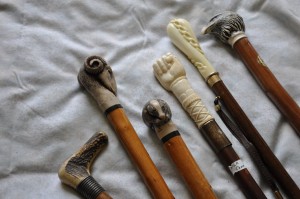Carved Ivory
Ivory, Porcelain, Whalebone even horns and antlers:
Canes are made from a great variety of materials, from almost anything that grows including woods of all types, from the four corners of the world, and other materials such as ivory and bone. The stick maker was limited in his material choices by availability and imagination alone!
Elephant ivory is distinguished by its translucent crosshatching as seen on cross-section. Cut lengthwise, these lines appear triangular or diamond-shaped. Also look for subtle translucent surface striations . It is a fine grain with an even, geometric appearance.
Walrus ivory often has a marbled or webbed pattern on finished pieces. It is easier to identify when both the outer or enamel layer, which is dense and white, and the inner, dentin layer, which has a honeycomb or tapioca-like appearance, are visible.
“Scrimshaw is the name unaccountably attached to the indigenous occupational pursuit of the whale hunters, employing by-products of the fishery to pass idle hours at sea.” Many types of objects were produced during the Golden Age of Scrimshaw, spanning the 1830’s and 1840’s. Pictorial scrimshaw existed before this, with the earliest known know works of engraved pictorial scrimshaw dating from circa 1817-21.2 Men aboard whaling vessels utilized basic materials available to them every day, sperm whale ivory, walrus ivory, baleen and skeletal bones. This was combined with other found materials including fragments of wood, abalone and other shells, metal and tortoise shell, often used for inlay work. Whalemen created a variety of objects, including canes, during the long days and years while away at sea.
